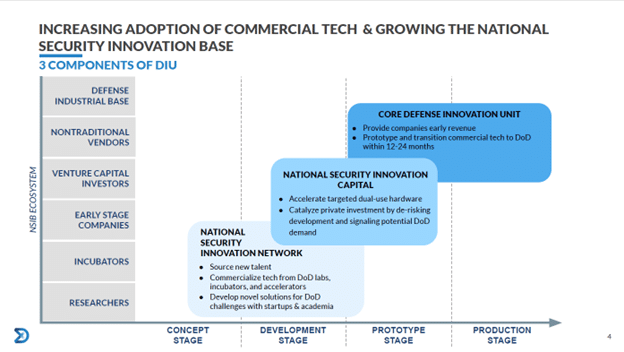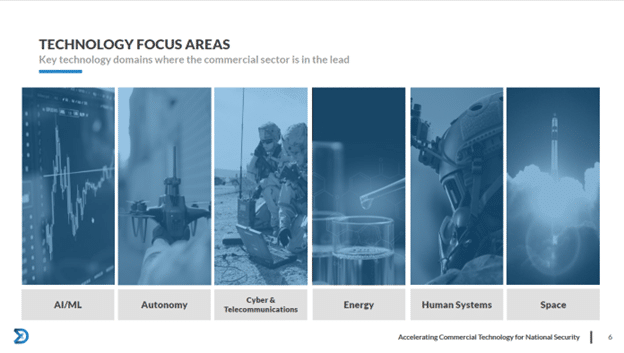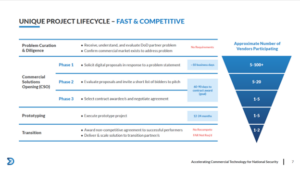The Defense Innovation Unit (DIU) helps the U.S. Department of Defense (U.S. DoD) move away from building everything itself and engage with commercial companies that are producing the technical capabilities that it needs.
Companies of all kinds and sizes in the U.S. and allied partner countries (including Canada) partner with the DIU as it is fast way to introduce technology to the U.S. DoD and is not aligned with any of the traditional service branches. Instead, it works with any mission partner that comes to it looking for commercial companies to solve national problems.

There are three components to the DIU. The Core Defense Innovation Unit works on solutions with high TRL (technology readiness levels) and is already in the production stage. They are looking for startups and smaller companies that are innovative, have the latest technology, are not burdened by a lot of bureaucracy, and can move quickly to solve defense problems.
The NSIC (National Security Innovation Capital) and the NCIN (National Security Innovation Network) work earlier in the product cycle, concept stage, development stage, prototype stage. NSIC accelerates targeted dual-use hardware and catalyzes private investment by de-risking development and signaling potential U.S. DoD demand. NSIN sources new talent and commercializes tech from U.S. DoD labs, incubators, and accelerators. It also develops novel solutions for U.S. DoD challenges with startups and academia.

The DIU is focused on six technology areas:
- AI/ML (foundational models, generational AI, modeling & simulation, training and interference hardware and operational decision support)
- Autonomy (Small drone swarming technology, unmanned maritime surface vehicles for ISR, autonomous navigation software for ground vehicles, counter unmanned aerial systems, logistics and advanced manufacturing, 3D interior navigation and mapping, fast mesh communications),
- Cyber and Telecommunications (security networks, remote usage out in the battlefield, software asset management, automated security validation, distributed, trustless data and execution model, post-quantum cryptography)
- Energy (battery technologies, vehicle electrification, grid-scale energy generation, environmental remediation, and waste-to-energy),
- Human Systems (wearable technologies, bioeconomy resilience, biodefense threat detection, prevention & countermeasures, human-centered tactical solutions, training (AR/VR), human performance), and
- Space (rockets, digital infrastructure in space, in-space logistics and modularity, hypersonics, persistent remote sensing, commercial delivery beyond LEO (satellites)).
The DIU does execute projects that don’t fall in one of these traditional six portfolios, but for the most part, the mission partners come to this unit for these six technology focus areas.

There are four stages in a DIU project lifecycle.
During the first stage, Problem Curation and Diligence, the DIU spends time talking with the mission partner about the problem that the mission partner is looking to solve with a commercial solution. This can take some time depending upon how much the mission partner has thought about the work at hand.
After the DIU understands the needs of the mission partner, they will work with them to come up with a general problem statement that will resonate with several vendors and start the multi-phase Commercial Solutions Opening (CSO) stage.
For phase 1 of the CSO, the DIU will publish a solicitation for approximately 10 business days and receive anywhere from 5 to 100+ responses.
During phase two, the DIU will evaluate all the responses against very specific criteria and select the parties that they want to come in to pitch to them. Vendors are given an hour or so to present their solution and participate in Q&A with the DIU and the mission partner.
For phase three of the CSO, the DIU selects the awardees and negotiates an agreement to prototype the solution. The companies that are selected for a prototype award will be notified and given a package which includes a request for proposal where the vendor can submit a formal proposal including prototype pricing, rough production pricing, timeframes, and other things that describe their solution. From there the DIU will execute a prototype contract. The DIU aims to sign a prototype agreement within 60 to 90 days from when solicitation closes.
The Prototyping stage lasts between 12 and 24 months. Most software projects are typically 12 months while the prototype stage for hardware projects is often 24 months. But the goal is to prove that the solution works for the Department of Defense.
Awards made by the DIU are called OTAs (Other Transaction Authority) which are simpler and faster. They typically include protections for the vendor’s IP (intellectual property) but will also include Government Purpose Rights (GPR) where the DIU owns any data that goes in and out of the vendor’s solution.
The final stage is Transition. The DIU will help to broker a production contract between the vendor and the mission partner. One thing to note – no recompete. If vendors are involved in a DIU commercial solution opening, are awarded a prototype contract and their solution(s) meets the expectations of the mission partner, then the vendors don’t have to recompete. The competition is considered to have been completed upfront, the solution is acceptable to the DOD and the vendor can sign a production contract.
Webinar Q&As
Yes, the DIU works with all six service branches, Army, Navy, Air Force, Marines, Space Force, and Coast Guard.
We are interested in knowing about new technologies. If you have an innovative solution, and you don’t see any solicitations out there, but you think we ought to know about you, send an inquiry and someone from the commercial engagement team may get back to you.
If there is no immediate need for your solution, our commercial engagement team will file it away for the day when a solicitation from a mission partner is a good fit. But we don’t serve as a business development arm for vendors.
Consortia is one way to be involved in an OTA, but not the only way. We do direct OTA awards to specific vendors or work with an integrator, who is submitting on behalf of a small startup vendor that wants to mitigate their risk.
There are no certifications required to work with us. Depending on the mission partner, there could be certifications that your solution would require to be suitable for their use. For example, depending upon the kind of data that might be involved – classified, top secret – you would need to achieve a certain level of certification from a U.S. DoD authority.
Software often requires two certifications – IATT (interim authorization to test) is required to release your solution for department use, and ATO which is needed to transition to production. Can DIU award your ATO? Not really, except for special circumstances. We can sponsor you for the ATO, we can sponsor you for the IATT but normally those will come from the mission partner themselves.
It is possible that they would overlap. Like I said, DIU tends to operate toward the higher TRLs and commercially available. DARPA is a sister organization within the DOD, but they tend to focus more on research and development.
Often someone comes to DIU and says, “We can develop this” and we will say, “Please call DARPA” or “Let us hand you off to DARPA”. DARPA tends to be just a little bit earlier in the lifecycle. We’re looking for solutions that are already developed and commercially viable.
If the solution really does cross multiple areas, bring them all to the four. Chances are a mission partner’s needs would be multifaceted in the sense that they want a drone that can communicate securely and have batteries that will last. Often one of the portfolios will take the lead and the others will supplement but the technology experts from all the portfolios are involved in evaluating the whole solution.
Do you have an opportunity with the U.S. DoD?
Contact CCC to learn more about how we can support your bid.

